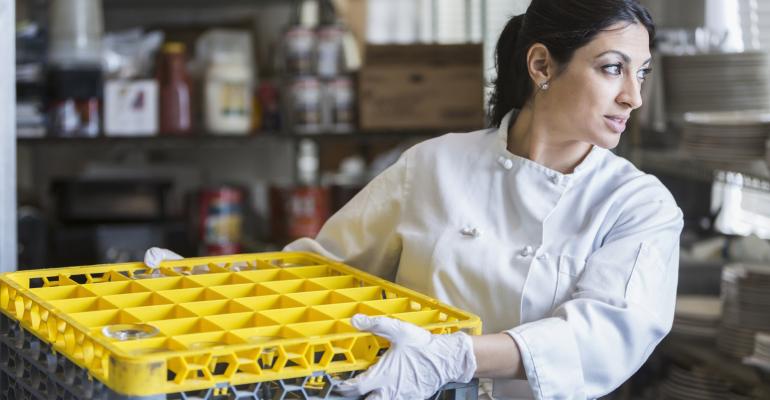Sponsored by Western Pest Services
A restaurant manager was baffled by a recent roach problem in his operation. “We’re clean,” he insisted to entomologist Jennifer Brumfield as she inspected the kitchen floor.
Indeed, the floor was sparkling clean. But then Brumfield popped off the fan housing under the stove, revealing about a half-inch of grease gunk — a prime food source for bugs.
When it comes to pest control, sanitation is more than just mopping floors or taking out the trash. Restaurateurs who maintain a thorough and in-depth cleaning schedule and make it a part of the everyday operations are better equipped to prevent pest problems, says Brumfield, who works for Western Pest Services, a pest control company based in Parsippany, New Jersey.
Keeping the restaurant environment pest-free not only protects a brand’s reputation but also prevents food contamination, as pests are carriers of such bacteria as E. coli and salmonella, which can make people sick. In addition, the saliva, droppings and decomposing bodies of cockroaches contain allergen proteins known to trigger allergy and asthma symptoms, especially in children.
It’s imperative to make cleanliness the standard operating procedure in a restaurant, Brumfield says.
“Usually it’s the managers and owners who care, and they need to instill that caring culture in their employees,” she says.
Here are some of the areas that often get neglected when it comes to sanitation, Brumfield notes.
Appliances
While the restaurant mentioned earlier had spotless floors, a population of roaches was living under the stove. Often overlooked are the undersides of appliances and underneath the covers of fans or motors. Sanitation includes getting under appliances, cleaning the legs and wheels of carts, stoves, tables, shelves, etc.
Lids
Usually operators make sure the dumpster is as far from restaurant doors as possible, Brumfield says. However, often she’ll see them with the lids flipped back, leaving the dumpsters open and uncovered — an inviting home for flies and rodents.
Drains
Floor drains are easy to overlook, but over time the drain basket in the drain can become clogged with pest-attracting food debris. Clogged drains also can create standing water, a breeding ground for roaches and fruit flies.
Brumfield will grab a pair of pliers and pick up the drain basket to show restaurant employees how much dirt has been collected.
“It’s disgusting,” she says. “You have to pull these on a regular basis and run them through the dishwasher.”
Operators also can purchase an enzyme from their pest control provider to keep drains clean. The enzyme is a biological agent that eats away at the goo building up in the drain, she says.
The bar
The bar area, with all of its sweet mixes and fruit, can become a breeding ground for pests — in particular fruit flies — if operators are not vigilant about keeping the area clean during shifts and after hours.
Employees should make sure liquor wells are cleaned out. Spills and splashes should be cleaned up immediately, including floors and under the surfaces.
Delays
It’s easy after a long, busy night to conduct a minimal cleaning, lock up and go home and do a deeper cleaning in the morning, says Brumfield. However, roaches and rodents are much more active at night. While employees are sleeping, the pests are contaminating surfaces, infecting food supplies and multiplying.
Instead, operators need to take the time to thoroughly clean at night and properly store all food products, Brumfield says.
Mops
Often, operators will leave soap and water and the mop in the mop bucket — at the ready for any sudden spills. Standing water, however, attracts pests. Unused mop buckets should be kept empty and mops and squeegees should be hung up off the floor.
“I have seen fruit flies breeding in mop heads,” Brumfield says. “Empty out the mop bucket after every use.”
Trash bins
While employees may be quick to take out the trash, often the trash bins themselves get ignored. Seepage from over-stuffed or ripped trash bags can accumulate inside the trash bin, attracting rodents and flies. The bins also need to be washed out and kept clean.
Linens
Dirty linens kept in hampers or canvas bags need to be emptied frequently, says Brumfield. One of her tests is to give a dirty linens bag a quick kick to see if that disturbs any loafing flies.
Produce
Make sure produce which is kept at room temperature — such as onions or potatoes — is rotated to the top when newer product comes in. It only takes one onion with a soft spot to start a problem, Brumfield says. In addition, always take the time to inspect deliveries. Examining the produce is important, not only to check the quality but also to make certain a vendor is not bringing in pests that are attempting to stow away in cardboard boxes.
Traps and hoods
Operators should have professionals clean grease traps and hoods on a regular basis. Also, when it comes to hoods, inspect the area where exhaust exits the building and make sure grease is not accumulating up there as well.
Overall, the cleanest restaurants Brumfield sees are the ones that have a structured approach to sanitation, such as check lists and cleaning schedules.
“Restaurants with zero accountability tend to be the messier ones,” she says.




